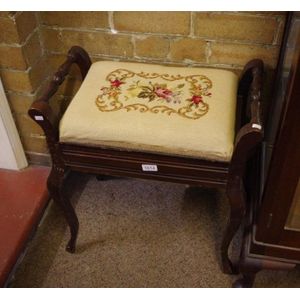Georgian and Charles II Style Tables
A Charles II style hardwood side table and a Georgian style mahogany torchere, the table with a rectangular top above a plain frieze raised on 'Gun barrel' supports united by peripheral stretchers, the torchere with a spiral-turned pedestal raised on four outswept feet, the table 70 cm high, 70 cm wide, 47 cm deep. The torchere 148 cm high,
You must be a subscriber, and be logged in to view price and dealer details.
Subscribe Now to view actual auction price for this item
When you subscribe, you have the option of setting the currency in which to display prices to $Au, $US, $NZ or Stg.
This item has been sold, and the description, image and price are for reference purposes only.
- Georgian - As an English stylistic period, Georgian is usually taken to cover the period from George I (1714) to the Regency of Prince George (1811-20), although the period from 1800 to 1830 is sometimes designated as the Regency period. During the Georgian period the great English cabinetmakers and designers such as Chippendale, Hepplewhite, Adam Sheraton etc., were all active.
Therefore there isn't a single 'Georgian style' as such and to say something is 'Georgian', usually means it was made between 1714 and 1830. This assumes we discount George V and George VI, both being from the 20th century.
The styles popular at the time of each reign were:
George I (1714-1727) saw out the last years of the Baroque period.
George II (1727-1760) reigned during the Rococo period.
George III (1760-1820) saw the last gasp of the Rococo, all of the early Neo-Classic 'Adam style' and most of the later neo-Classic 'Regency style'.
George IV (Prince Regent 1820-1830)encompassed the last of the 'Regency' style.
William IV's reign (1830-1837) was something of a no man's land (stylistically) and he wasn't a 'George' anyway. He covered the last glimmerings of 'Regency' and the start of the 'Victorian' style. - Mahogany - Mahogany is a dense, close grained red-coloured timber from the West Indies and Central America. It was first imported into Europe in the the early 18th century and its use continued through the 19th century. It was popular for furniture making because of its strength, the wide boards available, the distinctive grain on some boards, termed flame mahogany and the rich warm colour of the timber when it was polished.. The "flame" was produced where a limb grew out from the trunk of the tree, and this timber was usually sliced into veneers for feature panels on doors, backs and cornices.
Some terms used to describe mahogany relate to the country from which it originally came, such as "Cuban" mahogany, "Honduras" mahogany etc. However unless the wood has been tested the names assigned are more a selling feature, rather than a true indication of the timber's origin. - Frieze - An architectural term denoting the flat, shaped or convex horizontal surface of furniture, between the architrave and the cornice, usually found on a cabinet or bookcase, or on desks and tables where it may include drawers, the area between the top and the legs. In ceramics, the term refers to the banding, of usually a repeating pattern, on the rims of plates and vases.
This item has been included into following indexes:
Visually similar items

Vintage tapestry top piano stool, 55 cm wide, 32 cm deep 58 cm high
Sold by
in
for
You can display prices in $Au, $US, $NZ or Stg.

9ct gold curb link fob chain, approx 47.5gms and 53 cm long
Sold by
in
for
You can display prices in $Au, $US, $NZ or Stg.

A tall bronze vase stand decorated with shield and arrow motif. Height 31 cm
Sold by
in
for
You can display prices in $Au, $US, $NZ or Stg.

Rustic green bushmans kitchen dresser, circa 1930s, wooden painted sideboard and similar chair and stool (3)
Sold by
in
for
You can display prices in $Au, $US, $NZ or Stg.
